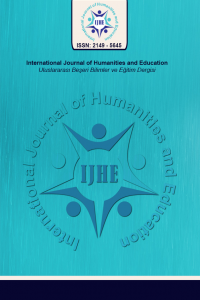Education and Real Religious Life
Religious studies at secular schools and universities aim at the disclosure, comprehension of laws, trends, driving forces, main stages of religious history. There is a problem of interaction of secular education and religious sphere of modern culture. Secular education tends to give students scientific image of reality, in particular neutral information about different religions. Many students and their teachers have personal religious beliefs and it’s hard for them to be neutral. The aim of this paper is to investigate the problem and find ways to harmonize this contradiction.
Anahtar Kelimeler:
Tolerance, Religiosity, Secular education, Religious life problems, Russian culture
___
- Eerdmans’ handbook to world’s religions. (1991). Seattle: Eerdmans Publishing Company.
- Johnstone, R. L. (1997). Religion in Society: a sociology of Religion. New Jersey: Prentice Hall. Lenin, V. I. (1965). Socialism and
- Religion: Lenin. Collected Works. Volume 10, p.p. 83-87. Moscow: Progress Publishers.
- Livingston, J, C. (1993). Anatomy of the Sacred: an introduction to religion. New York, NY: Macmillan Publishing Company.
- Marx, K. (1955). Critique of Hegel's Philosophy of Justice. Introduction: K. Marx and F. Engels. Writings, Volume 1. p.p. 414 – 429. Moscow: State publishing house of political literature.
- The synergetic philosophy of history. (2009). Branski, V., Pozharsky S. Saint – Petersburg: Copy - Print.
- On religion and interfaith relations. (2016). Retrieved from http//www.znak.com/2016-03-24/na_tyumens
- Pomerantsev, P., (2012). Putin’s God squad: the Orthodox Church and Russian politics. Retrieved from http://www.newsweek.com/putins-god-squad-orthodox-church-and-russian-politics-64649 Russians about religion and churches | Levada-Center. Retrieved from http//www.levada.ru/2012/10/11/rossiyane-o-religii-i-tserkvi/
- Başlangıç: 2015
- Yayıncı: Halil TURGUT
Sayıdaki Diğer Makaleler
Üniversitelerde, Atatürk İlkeleri ve İnkılap Dersleri Nasıl Olmalıdır?
Seda TÜRKÖZ, Beliz KÖROĞLU, F. Sülen ŞAHİN KIRALP
Mapping Principal Preparation Programs in British Columbia, Canada
John CHURCHLEY, Victoria HANDFORD, Patricia NEUFELD, Diane PURVEY
Dîvânu Lugâti’t Türk’te Savlar ve Kültürel Kavramlaştırma
Tarih-i Ferhengi İl-i Şahseven-i Bağdadi, İntişarat-ı İl-i Şahseven-i Bağdadi
Eğitime Katkılarıyla Kazım Karabekir
Hürü SAĞLAM TEKİR, Süleyman TEKİR
Sykes-Picot’dan Günümüze; Suriye ve Irak Üzerinde Siyonizm’in Yüz Yıllık Hedefleri
